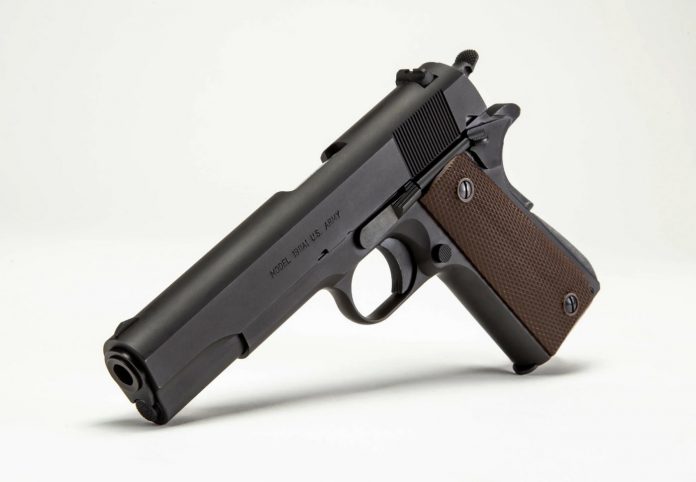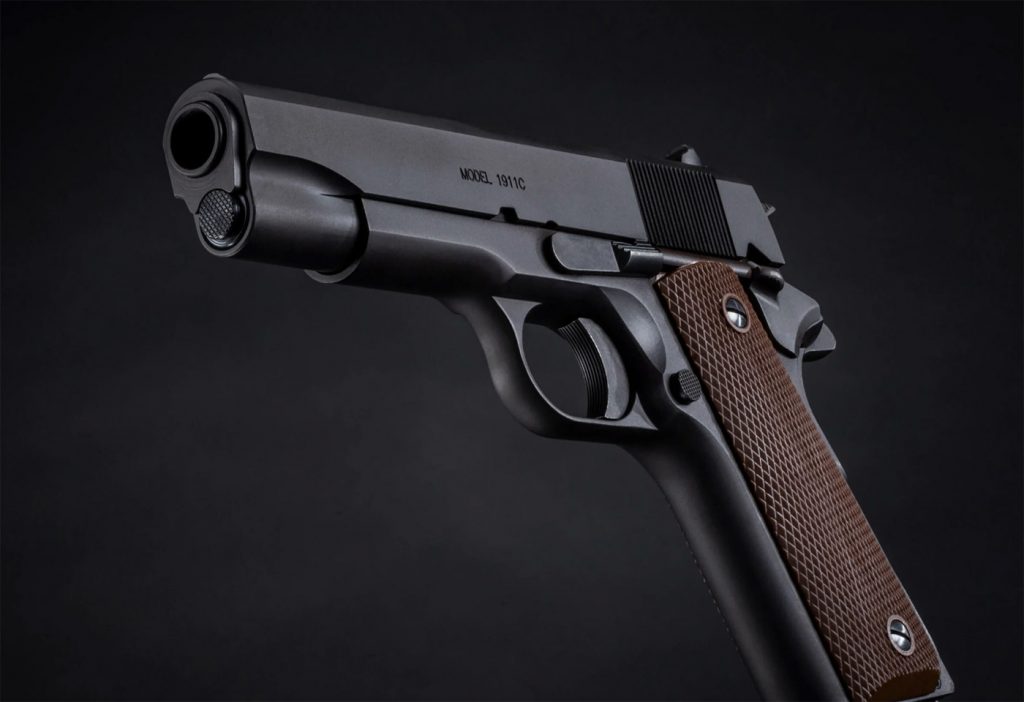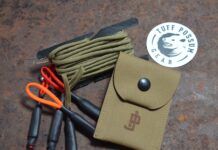
The 1911 reviewed today is a close copy of the original US Miliary 1911, at least those manufactured after 1924. The early pistols were 1911 handguns the 1911A1 featured certain improvements such as an arched mainspring housing, finger cuts in the frame, improved sights and beavertail safety re-design, and short trigger. The Auto Ordnance 1911A1 is an American made handgun with a dark matte finish, plastic grips, and good fitting and attention to detail. This is a Government Model 1911A1 with a five inch barrel. Overall length is 8.5 inches. The pistol weighs 38 ounces. The pistol is supplied with a single 7 round magazine. Early features such as a lanyard ring and small sights are part of the package. The pistol isn’t difficult to operate. Load the magazine, rack the slide to the rear, insert the magazine, and lower the slide. Place the safety into its notch in the slide. The pistol is then cocked and locked. Some modern pistols claim cocked and locked but they are really only cocked and safety on. The 1911 safety locks the slide in place when applied. A grip safety prevents travel of the trigger unless the grip safety is pressed forward. The Auto Ordnance version releases its hold properly about half way into travel. No matter how hard you pull the trigger the hammer will not fall if the safety is applied. If you drop the pistol the grip safety springs out and prevents hammer movement. The slide serrations are true to the original 1911A1 and the pistol is easily field stripped in true 1911 form. The sights are embryonic fixed units. While we could hit better with larger sights then this would not b a true 1911A1 reproduction, an important point. While such sights are fine for short range use they are difficult to use at extended distances. I am not certain the Army intended them simply for short range combat and shooting enemy horses. Military accuracy standard with 230 grain jacketed service loads were a five inch group at 25 yards and a ten inch group at 100 yards. Most 1911 handguns of the day were more accurate than this. Since the pistol fits most hands well with a good natural heft the small sights are not as great a hinderance as we might think.


The ejection port – sometimes called slide window in period reports- is small. So was the original. Modern enlarged ejection ports made administrative handling much easier. There are differences between the Auto Ordnance and original as may be expected. The pistol is a little tighter with less lateral play between the slide and the frame than a wartime 1911. We like our pistols to be accurate more so than we need them to come up shooting after a drop in the mud these day. The second addition is a firing pin block. This prevents forward travel of the firing pin if the pistol is dropped, particularly if dropped on the muzzle. This doesn’t affect the trigger action as the Auto Ordnance pistol features a trigger that breaks at a clean 7.2 lbs. Forgings are stronger than steel and the primary action parts of the 1911A1 are steel. A 1911 must have 1/32 inch clearance between the two halves of the feed ramp for proper feeding. The Auto Ordnance neatly accomplishes this. The top of the chamber should also be smooth. This handgun accomplishes this as well. The barrel bushing is snug but only finger tight.
Firing the handgun was pleasant enough. I chose Black Hills Ammunition 230 grain FMJ ammunition for test firing. This is the original ‘hardball’ loading or close enough. At 850 fps this is a formidable load. Powder burn is clean and as a result of this full burn muzzle signature is limited- just a few sparks at best. At 7 yards the pistol was quickly brought to eye level and fired. I chewed up the target center. At longer range you must concentrate on the small sights. With good light and a target of contrasting color good results are possible. At a long 25 yards I destroyed a man sized target. Firing from the MTM Caseguard K zone shooting rest I carefully benchrested two loads. First, the BHA 230 grain FMJ. I added the Black Hills 230 grain JHP as well. The FMJ load put five rounds into three inches and the 230 grain JHP three rounds into 2.9 inch- four of them in 2.2 inches. The pistol is reliable and accurate as far as I can tell from firing 120 rounds.


If you chose to carry this handgun cocked and locked hammer to the rear and safety on is the preferred carry. This makes for rapid manipulation and a fast first shot hit. Sure you may wish to purchase a modern 1911 with superior sights and a crisp trigger action. If you respect the .45 ACP cartridge as I do then you may deploy a Glock 21. Just the same if you wis to own a 1911A1 that is reliable and functions well this is the one.

Auto-Ordnance 1911A1 Specs
- Caliber: .45 ACP
- Capacity: 7+1
- Barrel Length: 5.0″
- Overall Length: 8.5″
- Height: 5.5″
- Width: 1.34″
- Weight: 38 ounces
- Slide Material: Steel
- Frame Material: Steel
- Safeties: Grip safety, thumb safety, firing pin safety
- Sights: Ramp front, notch rear
- Trigger: 7.0 lbs.
- Accessories: One 7-round magazine, cable lock
- Manufacturer: Auto-Ordnance



